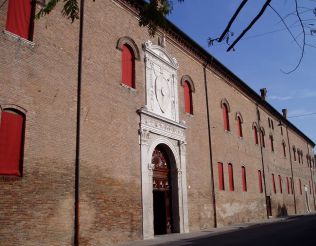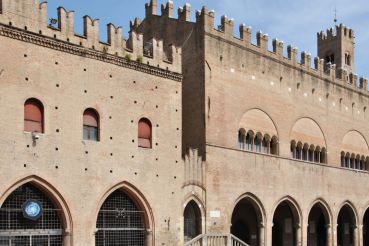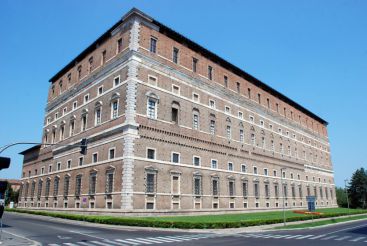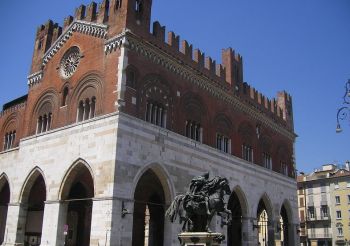Schifanoia Palace, Ferrara

Schifanoia Palace (Palazzo Schifanoia) in Ferrara is an incredible example of medieval art. And its main tresures – unique frescoes of the Renaissance – are hidden inside the building. Once they had decorated a place for the entertainment of local nobles, now they attract researchers from all over the world for more than one century. In addition, the City Museum of Ancient Art is situated here.
History of the palace
The palace was erected in 1385 by the order of the lord of Ferrara, the Marquis Alberto V d'Este. The Palazzo was designed for recreation and entertainment of the nobility of the city. And its name comes from the Italian expression "schivar la noia", which denotes the scorn of boredom and longing. By 1391 the building was expanded. In 1450-1471 the Duke Borso d'Este reigned in the city. In 1465 he ordered the architect Pietro Benvenuti degli Ordini to substantially alter the palace. After the completion of the works and the decoration of the Hall of the Months in 1469-1470, the palazzo acquired the appearance that has survived to this day. In 1493 the architect Biagio Rossetti carried out the last completion of the eastern wing.
In 1598 the family d'Este left the city, and the mansion passed into the hands of the younger branch of the house. In 1703 the building was sold to the Tassoni family. The latter, in turn, gave part of the palazzo to a tobacco factory. Precious frescoes were buried under a layer of white plaster, the beautiful palace fell into decay. After the Napoleonic wars, the estate became the property of Giacomo Mayol. In 1821 the palace was restored by the efforts of the painter Giuseppe Saroli. The opening of the frescoes caused a real stir, and in subsequent years they were restored by a number of skillful masters. On November 6, 1897, it was decided to open a museum, and on November 20, 1898 the City Museum of Ancient Art was founded in the palazzo.
Interior of the palazzo
The real decoration of the interior of the palace was the cycle of the frescoes of the main hall. Subsequently, it received the name "Hall of the Months". The cycle was created based on the needs of the duke, ancient mythology and Arab astrology. This idea was realized by the astrologer and librarian Pellegrino Prisciani. The duke invited famous artists Francesco del Coss and Baldassare d'Este to work on the frescoes of the hall. Presumably, Ercole de Roberti, Gherardo di Andrea, Fiorini da Vicenza also worked with them. The hall has a length of 25 and a width of 11 meters, and its height reaches 7.5 meters. Thus, the total area of the drawings is 525 square meters. Such dimensions make the cycle one of the greatest creations of the Renaissance.
The whole cycle is divided into 12 sections, corresponding to the months of the year and the signs of the zodiac. Only 7 of these are well restored. Each part consists of 3 blocks. The upper blocks depict ancient deities, patrons of the zodiac signs and months. Below them, in the middle tier, the corresponding signs of the zodiac are depicted. And the lower block has images of worldly life in certain months, reflecting the turnover of the stars in the starry sky.
Another valuable premise of the palace is the hall of virtues. This is the entrance hall of the main hall. Its decoration was taken up by artists Bongiovanni di Geminiano Gabrieli and Francesco del Cossa. The walls are decorated with gilt friezes with festoons, garlands and cherubs, among which the coat of arms of the duke stands out. Here there are pictures of the good deeds of the ruler of Ferrara. The illustrations of Christian virtues complement the frescoes: faith, hope and mercy. And the virtue of justice is probably replaced by the figure of the duke himself.
Museum of Arts
In the small rooms of the palazzo there is the City Museum of Ancient Art. There are exhibited various items, mostly dated to 13-15 century. Among them, ceramics, jewelry, coins, paintings and books. The whole collection is thematically divided into several parts:
- Numismatics. In the collection of coins and medals there are examples from ancient Greece, and also issued by the Papal and noble medieval mints.
- Manuscripts. The collection shows richly decorated ancient texts. Among them there are various religious books. A vivid example is the Decretum Gratiani, printed in Venice in 1474 and decorated with jewels for Bishop Lorenzo Roverella.
- Egyptian collection. There are about 200 exhibits in it, mostly different funerary and ritual objects.
- Collection of ceramics. The collection was recently acquired by the museum fund. It contains valuable examples of local craftsmen from the 14th and 17th centuries, artfully decorated with various images. A valuable collection of Giovanni Pasetti consisting of 800 samples of pottery from the Renaissance and the Middle Ages is also included here.
How to get there
The palace is located in the historic center of Ferrara, on Via Scandiana, 23. A large park area stretches not far from it, encircling the center of the city. The Archaeological and Jewish museums are also close. In 4 minutes walk there is a bus stop Alfonso d'Este Medaglie D'oro (routes 6, 13, 310, 322, 330, 342, 345).
Opening hours: at the moment (since January 8, 2018) the palace is closed for long-term restoration and anti-seismic activities. For information on the possibility of a visit, please call: (+39) 0532 244949





